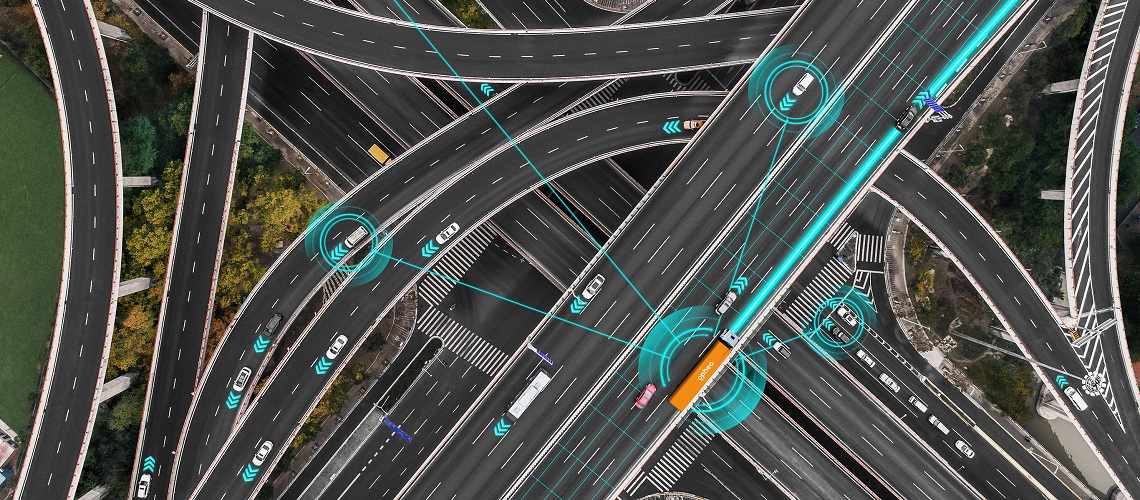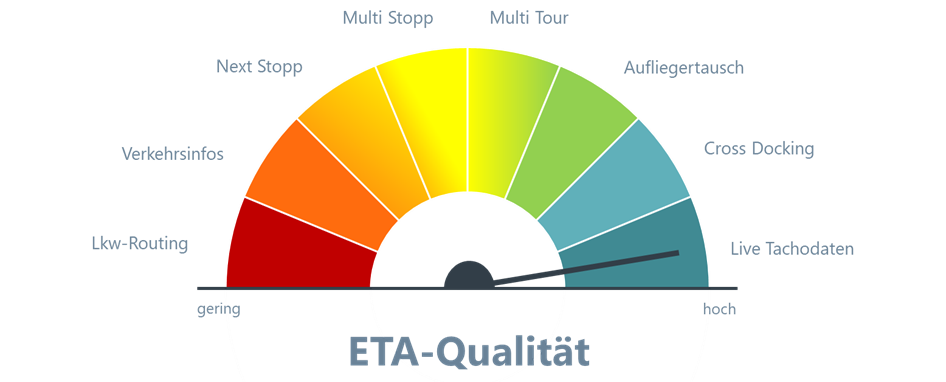teilen

Digital connectivity
ETA
Thursday, 03. March 2022
Bleiben Sie immer auf dem Laufenden mit unserem Blog-Abo!
Transparent supply chains thanks to ETA forecasting in the truck control system
Transport logistics plays a key role within networked supply chains. The highest possible transparency regarding the arrival times (ETA) of trucks is of great importance for both upstream and downstream processes. With the help of forecasting procedures, qualitatively good predictions of arrival times can be made. These are particularly valuable for the supply chain partners involved if they are available at an early stage. With the automated provision of good ETA forecasts, both shippers and logistics providers can offer their customers significantly higher service quality and real added value.
The value of transparent supply chains
Modern supply chains consist of different sub-processes that are interlinked to a high degree across companies. Transport logistics connects the sub-processes of the supply chain and the players involved in it with each other and plays a special role in the smooth functioning of the chain. This is all the more true since the focus is increasingly on just-in-time delivery to reduce storage capacities and capital commitment.
It is obvious that both shippers and carriers are interested in the highest possible transparency regarding the estimated time of arrival (ETA) of deliveries. While internal processes can still be planned and implemented comparatively reliably, this does not apply to external transports. Especially on the important road transport route, many external influencing factors ensure that the duration of a transport is subject to considerable uncertainty. Delays on the road can also cause traffic jams at the ramp because original plans can no longer be implemented.
How ETA forecasting can increase transparency
In order to create the greatest possible transparency for both the truck dispatcher and the other supply chain partners, ETAs can be predicted with the help of forecasting algorithms. In this context, we speak of ETA forecasting or ETA prediction.
It is important that two requirements are met:
- The ETA prediction has a high precision, i.e. there is a high degree of agreement with the reality that will occur later.
- The ETA prediction is available very early before the real time of occurrence.
If these two requirements are met, the ETA forecast is of high value for the dispatcher and supply chain partner. Because if the risk of a delivery delay is detected very early, there is often still the possibility to reschedule the delivery and thus avoid the delay. And even if rescheduling is not possible and the delay is therefore unavoidable, the impact is far less drastic if the supply chain partners are informed hours in advance. Both the loading or unloading processes associated with the time of arrival and all subsequent processes can then be adjusted in time and the negative effects of the delay minimised in this way.
“An ETA forecast must be accurate and available early.”
If, on the other hand, one of the above-mentioned requirements for the ETA forecast is not met, the use of the predicted ETA is either worthless or can even cause damage. This is because the adjustment of subsequent processes to an incorrectly predicted ETA may cause higher error and follow-up costs than an unexpected delay.
Ensuring precision and timeliness of the ETA forecast
Precision and earliness of the ETA forecast can only be ensured if all relevant influencing factors are included in the forecasting.
In the simplest case, only the ETA of the next stop of a vehicle is calculated. In this case, many transport management and telematics systems use the current vehicle position and the current congestion situation as input for the calculation – as is also known from car navigation systems. However, even for this simple case, such a procedure leads to imprecise predictions for truck traffic. For HGV traffic, HGV routing should always be included as well. Furthermore, the extrapolation of the driver’s driving and resting time situation is also of great importance in the ETA calculation, as the question alone of whether the break to be taken before arriving at the next stop has a considerable influence on the ETA.
Forecasts are difficult, especially when they concern the future.
Mark Twain
If the aim is to provide the ETA forecast at an early stage, it is of course not sufficient to calculate only up to the next stop. Rather, the ETA calculation must also be carried out for all subsequent stops of the tour as well as for all subsequently planned tours of a vehicle. This increases the complexity of the forecasting and thus the demands on the algorithm used.
The situation becomes even more complex when dependencies between several vehicles come into play, e.g. in the case of cross-docking, encounter traffic, trailer swaps or similar. In these cases, there is a network of dependencies that must be precisely mapped in ETA forecasting.
Source: own infographic
A detailed presentation of the influencing factors can be found in our blog post “ETA calculation for truck fleets” .
Communicate ETAs automatically
Of course, ETAs are not only calculated once, but are continuously revised based on the current tour status and traffic situation. The results can be presented to the truck dispatcher, for example, graphically in the form of a continuously and automatically updated Gantt chart. However, added value for the other supply chain partners only results when the data is also made available to them at an early stage. In order to minimise the communication effort in scheduling, this data provision should be as automated as possible.
Various technical options are available for automatic provision:
Automatic advice
Advices are a way of actively notifying the customer by e-mail or SMS about the arrival time of their consignment. Intelligent transport management systems are able to send the advice messages independently and fully automatically when predefined events occur. Such trigger events can be, for example, the completion of the loading of a consignment, falling below a certain distance or travel time to the destination or a serious deviation of the new ETA forecast from the previous one.
Online tracking
With online shipment tracking, the end customer can track the status and ETA of their shipment at any time on a web platform. The ETA information is automatically updated on an ongoing basis using the latest forecast. In contrast to automatic advices, the end customer has the advantage of being permanently informed about the current situation. At the same time, however, they run the risk of not noticing changes in the ETA forecast.
Arrival monitor
The arrival monitor is a third option for automatically informing your own production or warehouse staff. This should be set up or hung up as clearly visible as possible for all employees and contains an overview of the arrival times of the next trucks. The focus of the information here is not so much on an individual consignment, but on the control of the loading or unloading processes resulting from the vehicle arrivals.
Conclusion
The forecasting and provision of ETA data is essential for the transparent management of supply chains. Those who want to calculate ETAs and pass them on to their customers should rely on good-quality ETA forecasting that is able to calculate ETAs even across many stops and tours and take into account specific influencing factors of the truck transport business.

